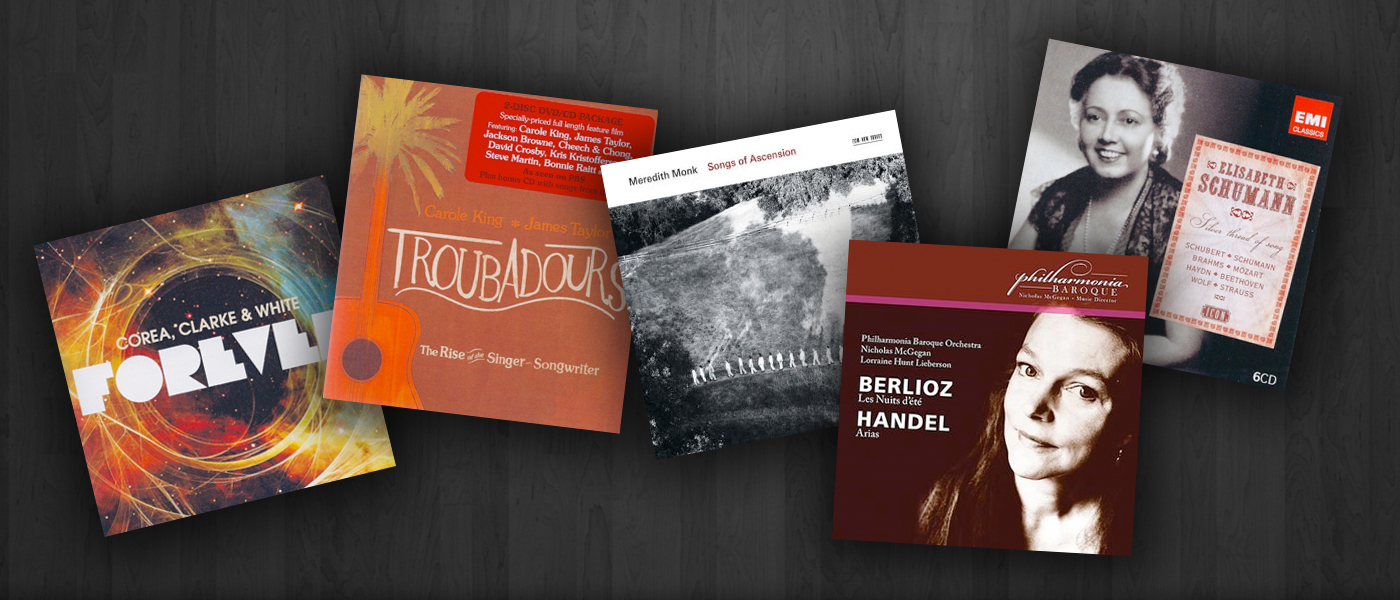The Bay Brass “Sound the Bells!” American Premières for Brass • Harmonia Mundi HMU 807556
- Performance:

- Sound:

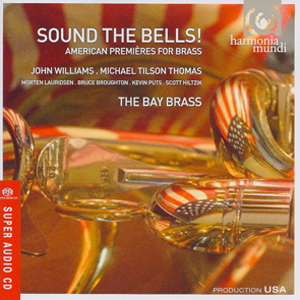
If there’s any way to change weather patterns with blasts of focused air, the 13 members of the 16-year old Bay Brass stand of good chance of transforming the San Francisco Bay Area as we know it. These members of the San Francisco Symphony, San Francisco Ballet, San Francisco Opera, and other regional orchestras have certainly given my ear canals the rotor rooter treatment. Sound the Bells!, their new recording on the Harmonia Mundi label, presents The Bay Brass in high-resolution, hybrid SACD format. I don’t know how this disc sounds in a surround system equipped with an SACD player, but its two-channel presentation is spectacular. Unapologetic in its brash and percussive assault, yet surprisingly mellow when the occasion warrants, it supplies enough high power wind playing and full throttle drumming to insure that your neighbors will know exactly what you’re listening to.
Sound the Bells! is also quite wonderful. A collection of American premieres, several of which were commissioned by the ensemble, it showcases The Bay Brass’ supreme musicality. Once you find a volume level sympathetic to system and sanity, it’s hard not to love this recording.
One of the best compositions on it is Michael Tilson Thomas’ Street Song. Originally composed for the Empire Brass Quintet in 1988, it was rescored for the larger London Symphony Orchestra brass ensemble in 1996. The Bay Brass gave the U.S. premiere a year later, with no less a personage than MTT conducting the usually conductor-less ensemble. MTT’s compositions haven’t always elicited universal acclaim, but Street Song is very special. Its touching second movement, with echoes of Copland’s Appalachian Spring, is as beautiful as its jazzy conclusion is catchy.
John Williams of Star Wars and everything else fame contributes the title selection, two minutes of unalloyed fun, plus two more proper, royal-sounding fanfares. Nothing outstays its welcome. Choral composer Morten Lauridsen, whose O Magnum Mysterium has been sung by just about every choral group west of the statue of Liberty, juxtaposes a brass arrangement of that sacred choral classic with a jazz-tinged Fanfare for Brass Sextet, dedicated to The Bay Brass. I can’t pretend that the brass O Magnum Mysterium evokes the same “great mystery†and “profound inner joy†of the birth of Christ and the veneration of the Virgin Mary as the choral rendition, but the huge intake of air at the start of the piece certainly injects a note of humanity into the proceedings.
Far more successful is another work prepared for The Bay Brass, Kevin Puts’ lovely Elegy. Puts, who served as Young American Composer-in-Residence with the California Symphony for several years before achieving international fame, has managed to retain the elegiac impact of a work originally conceived for string quartet.
Rounding out the program are two works written for The Bay Brass, Bruce Boughton’s fine Fanfares, Marches, Hymns and Finale and Scott Hiltzik’s sonically spectacular if musically slight Spirals. Broughton will conduct his work at a special Bay Brass CD release concert, scheduled for March 27, as part of a diverse program that includes the early music of Heinrich Schutz and the modern jazz of Pat Metheny. The acoustic should be ideal for the ensemble. Just don’t sit in the first row.
SPECIAL DOUBLE REVIEW:
Mezzo-Soprano Frederica Von Stade At Her Peak “Frederica von Stade” Song Recital (with Martin Katz, piano) • Sony 78516
- Performance:

- Sonics:

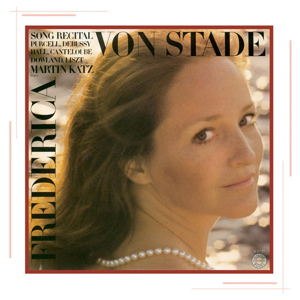
A priceless cache of out-of-print recordings by the beloved mezzo-soprano Frederica von Stade, 65, has just become available for the first time in CD format. Arriving soon after Flicka, as she is often called, bid farewell to the operatic stage with performances of Heggie’s Dead Man Walking in Houston, they afford a generous sampling of her artistry in first bloom.
First to arrive, the result of a collaboration between Sony Music and ArkivMusic.com that has also produced a indispensible collection of early Shirley Verrett recitals, are transfers of four analog LPs recorded when Flicka’s voice was in first bloom. Judging from the repertoire on her Duets album with soprano Judith Blegen (rec. ‘74/’75), Song Recital (rec. ’77), Mahler Songs (rec. ’78), and Italian Opera Arias (rec. ’79), all parties understood early on that, as much as Flicka’s voice and personality lent themselves to the wide-eyed, extroverted innocence of Mozart’s delightful Cherubino in The Marriage of Figaro, her unique gifts were showcased best in music that expressed intimacy and sadness.
Of the four CDs, the most indispensible is her song recital with the wonderful pianist Martin Katz. Each note bespeaks a rare and total rapport between two gifted artists. The naked sincerity of their performances also reflects how close von Stade was to the font of creation. On December 21, 1977, just two days after she recorded the recital, she gave birth to her first child.
Von Stade’s extraordinary emotional commitment is distinguished by sincerity that can best be termed devotional. The soft, sweetly voiced third verse of the opening selection, John Dowland’s oft-recorded “Come Again, Sweet Love Doth Now Invite,†is a revelation. Has anyone ever invested the words “endless misery†with such heart-tugging warmth and beauty?
The recital also contains the finest performance of Liszt’s great “Oh! Quand je dors†I have yet encountered. Taken slowly, with complete freedom from the slavery of the metronome, the performance underscores the depth of intelligence with which von Stade invested her artistry. Perfectly supported by Katz, she voices Liszt’s high, arching phrases as mere wisps of sound, each more heartfelt than the other. After an extremely passionate middle section, she returns to the opening melody with even greater slowness and intimacy. The final phrase, which she miraculously manages on a single breath, ends with a wondrous soft high A-flat that lasts a good eight seconds. If its release is not totally clean, it was probably because her eager-for-birthing child was giving signs that there was simply no time for a retake.
In addition to music by Purcell and Canteloube for which she is ideally suited, von Stade demonstrates that she was born to sing Debussy. Her Chansons de Bilitis, like her Mélisande in Debussy’s Pélleas et Mélisande, rivals the best. Just as treasurable is her extremely inward performance of Carol Hall’s “Jenny Rebecca.†Von Stade loved the song so much that she intended to name her eager-to-be-born daughter Jenny Rebecca. When Flicka sings “Jenny Rebecca, four days old,†the performance comes but six days early.
Frederica von Stade “Duets (with Judith Blegen, soprano)” Sony 78514
- Performance:

- Sonics:

Frederica von Stade “Sings Italian Opera Arias” Sony 78518
- Performance:

- Sonics:

Frederica von Stade “Song of a Wayfarer, Rückert Lieder” Sony 78517
- Performance:

- Sonics:

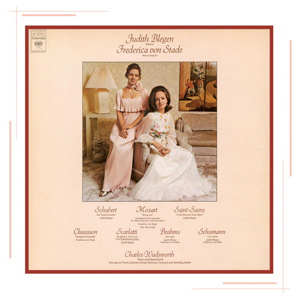
The other prize in this cache of von Stade reissues is the duet album with Blegen that includes both duo and solo excursions by the two artists. Their voices, with Blegen’s lighter and cheerier, balance each other quite well, and their renditions of rarely heard duets by Schumann and Brahms are extremely fine. Although in solo performances, Blegen’s technique in Scarlatti pales beside that of the best of today’s early music sopranos, von Stade is superb in Chausson’s Chanson Perpetuelle and Mozart’s “Non so più.â€
The other two CDs are not as perfect. As much as von Stade’s emotional affect is absolutely right for Mahler’s four Songs of a Wayfarer, five Songs from Rückert, and two songs from Des Knaben Wunderhorn (The Youth’s Magic Horn – I know, why did Columbia originally print the title of this cycle in German and the others in English translation?), she’s too fast in the exquisite “Ich atmet’ einen linden Duft,†and too heavy in the droll “Wer hat dies Liedlein erdacht?†(Who thought up this ditty?). Conductor Andrew Davis must have had something to do with that.
Similarly, one wonders if, on the Italian Opera Arias reissue, conductor Mario Bernardi was responsible for the slowness of the coloratura Rossini’s “Di tanti palpiti†and Bellini’s “Bel raggio lusinghier.†Flicka, after all, was known to dispense the challenging coloratura of Rossini’s finale from La Cenerentola at quite a fast clip. Regardless, the beauty she brings to her 13-minute “Torna, torna†from Monteverdi’s Il ritorno d’Ulisse in patria,†ably partnered by mezzo Janice Taylor, makes the CD a must-listen.
Now, for some major gripes. At a time that classical music is being increasingly marginalized in the United States, it is unconscionable that these collaborative efforts from Sony and ArkivMusic are sold at full price yet fail to include English translations. Translations were supplied with the LP issues, and are presumably still available. Equally upsetting is the digital ringing around the voice on some of these recordings that I do not recall on the LPs. While the originals did not represent analog technology at its finest – the basic timbre of the Song Recital is a bit metallic – there was no reason to compromise them further by sloppy work.
On March 22, EMI is slated to release what I believe will be the first CD issue of Flicka’s recordings of Fauré’s Mélodies with Jean-Philippe Collard. This very early digital effort, recorded in December 1981 and June 1982 when von Stade was 37, also includes her recording of “Mélisande’s Song†from Fauré’s Pelléas et Mélisande with Orchestre du Capitole de Toulouse under Michel Plasson. Although early digital recordings hardly excel in warmth, one can hope EMI has taken the extra time to remaster the sound in ways that compensate for digital infancy. Let’s see if they also include translations.
The bottom line: beggars can’t be choosers. I’ve been begging silently for a CD of the Song Recital with Katz for years. At last, it and four other long out-of-print von Stade recordings are available on CD. May a host of her opera recordings and other recitals come next.
The reviews that follow originally appeared at sfcv.org, the website of San Francisco Classical Voice
Joyce DiDonato “DivaDivo” Virgin Classics 419866
- Performance:

- Sonics:

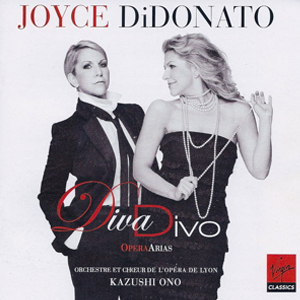
Mezzo-soprano Joyce DiDonato’s 2010 disc, Rossini: Colbran the Muse, sure is a tough act to follow. Not only did it net the Kansas-born artist Gramophone Magazine’s 2010 Recital of the Year award, but it also helped crown her that magazine’s Artist of the Year. Which is all the more reason to stand up and holler about her latest recording, DivaDivo (Virgin Classics), which displays an artist so on top of her form that it has a good chance of snaring another round of awards.
First and foremost, there is the astounding versatility of the voice. For a mezzo distinguished in part by the dark fullness of her lower range, DiDonato begins the recital on an ecstatic high note, sounding like a soprano in Massenet’s high-lying aria, “Je suis gris!†from Chérubin. Catch her glorious high As and soaring spirit on the clip that accompanies this review. If ever there were a recital opener designed to make you sit up and take notice….
From there, it’s one high after another. Some may miss the sense of innocence a singer like Kathleen Battle brought to Susanna’s “Deh vieni, non tardar†from Mozart’s The Marriage of Figaro. Nonetheless, DiDonato’s very individual response to the opening recitative, “Giunse alfin il momento…†sets her interpretation apart from all others (in a good way). And if its high-spirited virtuosity that rocks your boat, try her breathtaking rendition of Rossini’s sparkling “Nacqui all’affanno,†his crown jewel at the end of La Cenerentola. DiDonato is one mezzo who doesn’t wait for the recap before she starts throwing in one dazzling variation after another. Only Cecilia Bartoli among today’s current bumper crop of mezzos can sing as brilliantly and as fast, and with such high spirits. The performance is sensational.
Equally remarkable is the album concept. Not only does it showcase DiDonato in both skirt and pants roles – seven “trouser roles†are represented – but it also counter-poses different composers’ takes on the same character. With both male/female and composer dichotomies playing against each other, DiDonato unifies the concept with the sheer brilliance of her artistry.
Here’s just a taste of what she offers. From different centuries, we’ve got Mozart’s Cherubino and Massenet’s Chérubin. Even more delicious, the juxtaposition of Massenet’s Prince Charming from Cendrillon with Rossini’s Cinderella from you know what. Gluck’s La clemenza di Tito gives us the trouser role of Sesto, while Mozart’s opera of the same name provides the skirt role of Vitellia. Characters from Gounod, Berlioz, Bellini, and Strauss present further contrasts.
The final impassioned selection, sung by the Composer in Strauss’ Ariadne auf Naxos, may form a nice bookend with Chérubin’s soaring opener, but it’s from such a different milieu than everything else that I find it a little unsettling. Nonetheless, it again underscores the mezzo’s versatility. Some may prefer a sound more virginal, innocent, or fragile for some of these characters, but no one in their right mind will scoff at the quivering sentiment and sheer beauty of tone with which DiDonato infuses these portrayals. A tour de force and then some.
Verdi “Simon Boccanegra” EMI Classics 50999 9 17825 9 5 – 2 DVD
- Performance:

- Sonics:

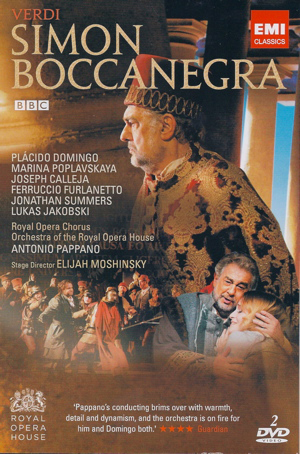
In tribute to tenor Plácido Domingo in his 70th birthday year, both EMI and Sony have released DVDs of his first foray into the baritone repertoire, the lead in Verdi’s opera Simon Boccanegra. Both performances took place in 2010, Sony’s at the Metropolitan Opera (simultaneously broadcast Live in HD) with James Levine conducting, and EMI’s at the Royal Opera House Covent Garden with Antonio Pappano in charge. As powerful as was Domingo’s Met performance of February 6, 2010, the superior cast and production at Covent Garden, recorded five months later, make it the DVD to own.
Surrounding Domingo’s Boccanegra are the exquisitely sung Amelia (Boccanegra’s daughter) of soprano Marina Poplavskaya, the beautifully voiced Gabriele Adorno (her lover) of tenor Joseph Calleja, the towering Jacopo Fiesco (one of Boccanegra’s enemies) of bass Ferruccio Furlanetto, and the ever-scheming Paolo Albiani (Boccanegra’s supporter turned assassin) of Jonathan Summers. Taken as a whole, this is one of the finer Verdi casts a house can assemble at this time.
Domingo is a marvel. Filmed over the course of three performances, to ensure that every scene catches him at his finest, he sings with sterling tone and utmost generosity of spirit. Absolutely steady of voice, he sounds each phrase like a master, living and feeling each of the intense emotions that make for riveting Verdi.
Because the role lies lower in Domingo’s voice, in a region unaffected by age, he is able to apply maximum pressure and still produce the burnished tones of his prime. As emphatic as the portrayal may be, everything is sung, without resort to shouting or coarseness. Concerns over whether his tenor timbre is suitable for baritone assumptions fade in the face of a portrayal of such vibrancy as to make baritone Dmitri Hvorostovsky’s recent Boccanegra in San Francisco seem wooden by comparison.
Poplavskaya may look far more Russian than Italian, but her voice is as lovely as her long blond tresses, and her portrayal is touching. The singing is not perfect, and she works hard at times, but the high C in her big aria, “Come in quest’ora bruna,†is gorgeous.
Calleja, now only 33, has developed into one of our finest tenors. While his warm timbre and sweetness on top make him ideal for lighter Italian roles, he also has sufficient power and thrust for Verdi. Veteran bass Furlanetto may not be able to summon up much color these days, but his dark instrument remains pretty steady, and far more inviting than the voice of the Met’s prone-to-bark James Morris. The vibrato of another veteran, Summers, may wobble a bit, but his Paolo is as despicable as Verdi must have wished.
Thanks to John Harrison’s brilliant and colorful light, each of Michael Yeargan’s palatial sets looks like a chiaroscuro painting of a Renaissance master. Pappano’s conducting rivals Levine’s – listen to how poetic the orchestra sounds, and how transparent the strings are before Amelia’s aria – and his very brief introductions before each act help focus the viewer’s attention. Director Elijah Moshinsky deserves equal credit for fusing acting and voice in such a convincing manner. It’s ridiculous that EMI omits chapter titles from its booklet, but that won’t stop anyone wishing to enjoy Domingo at his born again baritonal peak.


